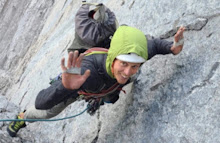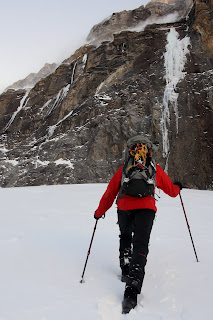FA: Raphael Slawinski, Niall Hamill Nov 22, 2019
The Sphynx in yellow, Banana Peel in red. Link to banana peel:
https://raphaelslawinski.blogspot.com/2019/11/banana-peel.html
Photo: Raphael Slawinski.
Approaching the wall, one of the great single day climbing venues in the rockies.
Photo: Raphael Slawinski.
Following pitch one. Photo: Raphael Slawinski.
Myself leading delicate ice on pitch two. Photo: Raphael Slawinski.
Raph following pitch two, just enough ice to be friendly above the vertical step.
Raph leading pitch three, while chatting casually to me. Harder than it looks.
Myself on pitch four, stemming comfortably from one solid ice feature to another, in a truly special position. I had longingly gazed at this ice feature hoping that I would some day climb it. Photo: Raphael Slawinski.
Swinging into the good stuff to top us out in the evening light. Who wouldn't want to climb this? Photo: Raphael Slawinski.
I had my eye on a couple of possible new lines this season on the storm creek headwall. Jon Walsh's recently published topo in Gripped Magazine showed some obvious (to me) (or so I thought) unclimbed lines to the left of buddha nature.
On Halloween, Quentin Roberts, Jas Fateaux and I were climbing a moderate new route in the sun on the other side of the valley and my eyes were drawn once again to these lines, from the best vantage point of the wall, where the topo photo was taken.
A couple of weeks later I was back, armed with a drill and a mission to climb through what looked to be some pretty blank rock below the ice streaks that led to the final ice pitch. I knew the start of the route would be easy enough, but the rock above there was a real question mark. Sure enough, when I got there eventually the featured seam I had been climbing on gear blanked out, and what separated passage to the thin ice strip was merely a few body lengths. I had been trending left, sinking in bolts, only to reach the ice finding that all the rock holds I had hoped to find were in fact not existent, and so I gently tapped into a centimetre of grey ice, then another tool, which somehow held me, and as I stood up and began to drill another bolt the ice collapsed on me. I felt a little defeated and headed down, thinking this project might not go until fatter ice conditions presented themselves.
In an email to Raphael Slawinski, we made plans for the following week and he casually asked if I had done a new route in that area of the wall. I replied that I had tried, and explained that I wasn't sure it would go this season. Providing a photo, he responded that he had been gunning for the same ice strip just a couple of days after, and taken a different start pitch, only to his surprise finding my bolted anchor at a stance. Seeing that I had gone up and right to an ice feature, Raph went up and left on rock and tried to gain another ice strip to the left of where I had been. Finding similar blankness, Raph called it a day.
We decided to join forces, and between our respective high points, and what we had learned, try to find a way through it. That is problem solving at it's best, part of the reason why new routing is continually interesting to me. What was very puzzling though, was a mystery piton that Raphael spotted just below his high point, and there is no way of knowing where that piton lead, since there was no tat or caribiner on it, we can only assume that mystery climber would have bailed from some other gear, or some ice up higher. It is possible that the first two pitches were climbed differently, as there are a handful of weaknesses that lead to the same ice features. We think it may be from the late Dave Thompson, an early pioneer of mixed climbing in this zone. If anyone knows about this piton, feel free to get in touch. We are very certain that the crux pitch we climbed on the third, was not ascended prior, for lack of natural pro in it's upper part, but if there was continually thicker ice on this part of the wall some year, ages ago, it is possible that the line had been climbed all on ice without any other fixed gear, and climbed completely differently than how we found it. Like many mystery pitons spotted by would-be first ascentionists in the range, there are often more questions than answers. In shifting conditions, over many years one must wonder what has been climbed and not reported.
Partnering with one of the best guys for the job, and a clever thinker at that, I felt a little more optimistic that it might go. We discussed options at the base and decided to take my initial line, but instead of traversing left, we would climb higher on the rock before breaking out left to the thin ice. Raph took pitch one, and I the second, making efficient work of it so we would have time to finish the bolting and (hopefully) red point pitch three. Sure enough, with just enough holds and a handful more bolts placed by Raph, the line of possibility was found, and we quickly pulled the rope so that Raph could give it his best. I battled through the crux of it following raph's impressive lead, (I wonder how many times this has happened in the rockies?) Just enough ice a little higher allowed passage to the big ledge below a fantastic final pitch of solid blue ice. I was grateful for raph's perspective and skill, as we shared ideas and options of how to climb this thing, and I was grateful to lead the final pitch, a classy one at that.
"The Sphynx" 125m, WI5 M7+
FA: Raphael Slawinski, Niall Hamill Nov 22, 2019
Left of the obvious flow of Buddha Nature on the Storm Creek headwall are three discontinuous ice lines. The Sphynx is the right-most one.
A couple of pitches of quality moderate mixed climbing with thin ice reaches an iced up slab below a bulging section of bulletproof rock. bolts supplement the upper dry crux as well as the beginning of the ice. A final ice pitch in an incredible position makes for a memorable finish.
Approach as for Buddha Nature (usually a donkey trail) and traverse a hundred metres or so left along the base of the cliff. The overhead hazard is minimal compared to some of the other routes on the headwall but the approach slope is steep enough to slide. 2 hours.
Climb:
Pitch 1 (30 m, M4+): Hook up a solid, featured corner with good gear, mantle onto a snow ledge, and follow an iced up ramp/groove to a ledge. Bolted belay.
Pitch 2 (30 m, M4 WI5): Climb a moderate rock step past two bolts. A short, vertical section of hollow thin ice protected by three bolts leads to an iced up slab that takes stubbies. Gentle with this ice, if it's in short supply the rock is tricky to dry tool. Belay at a single bolt. (Backup with screw.)
Pitch 3 (35 m, M7+ WI5): Hook a few face holds to reach a nice seam that provides good gear and secure hooks, a single bolt and fixed angle supplement the gear in the first half. Where the seam ends, bolts protect thin face holds. Before it becomes too desperate, better holds appear and ice patches that become a thin ice vein. The last two bolts on this pitch protect the 1-2cm thick ice that thickens as you reach a broad ledge. Ice screw belay.
Pitch 4 (30 m, WI5). Start up an iced up bulge, steeping to the right to gain the hanging curtain. Good ice leads to the top. Belay from screws before the ice turns into snow.
Left of the obvious flow of Buddha Nature on the Storm Creek headwall are three discontinuous ice lines. The Sphynx is the right-most one.
A couple of pitches of quality moderate mixed climbing with thin ice reaches an iced up slab below a bulging section of bulletproof rock. bolts supplement the upper dry crux as well as the beginning of the ice. A final ice pitch in an incredible position makes for a memorable finish.
Approach as for Buddha Nature (usually a donkey trail) and traverse a hundred metres or so left along the base of the cliff. The overhead hazard is minimal compared to some of the other routes on the headwall but the approach slope is steep enough to slide. 2 hours.
Climb:
Pitch 1 (30 m, M4+): Hook up a solid, featured corner with good gear, mantle onto a snow ledge, and follow an iced up ramp/groove to a ledge. Bolted belay.
Pitch 2 (30 m, M4 WI5): Climb a moderate rock step past two bolts. A short, vertical section of hollow thin ice protected by three bolts leads to an iced up slab that takes stubbies. Gentle with this ice, if it's in short supply the rock is tricky to dry tool. Belay at a single bolt. (Backup with screw.)
Pitch 3 (35 m, M7+ WI5): Hook a few face holds to reach a nice seam that provides good gear and secure hooks, a single bolt and fixed angle supplement the gear in the first half. Where the seam ends, bolts protect thin face holds. Before it becomes too desperate, better holds appear and ice patches that become a thin ice vein. The last two bolts on this pitch protect the 1-2cm thick ice that thickens as you reach a broad ledge. Ice screw belay.
Pitch 4 (30 m, WI5). Start up an iced up bulge, steeping to the right to gain the hanging curtain. Good ice leads to the top. Belay from screws before the ice turns into snow.
Descend: With 2 60m ropes, make a short rappel to the base of p4, and a 50m rappel straight down to a 2-bolt rap anchor (shown in topo) one rappel from here reaches the ground.
Gear: Single Camalots gold X4 to #3, 10 screws including a few stubbies, 15 draws including some extendables and 60 m ropes. No nuts or pins are crucial.












Costs Of Owning A Sphynx Cat
ReplyDeleteThe initial cost to purchase a Sphynx cat is one thing, but the costs of cat ownership is just as important to know about too. A Sphynx cat needs a little more attention than a normal cat, so you may end up spending more for some of the same items. Below is a breakdown of some of the costs you’ll run into when it comes to a Sphynx cat from the purchase stage as a kitten all the way to medical, food, cleaning, and other costs. Perhaps you'd like to check out our website tp purchase a sphynx kitten below.
http://sphynx.company.com